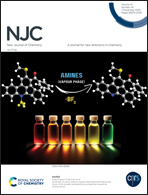PI/TiC/TiO2 with Z-scheme heterostructure for the photocatalytic degradation of organic dyes†
Abstract
The construction of photocatalysts with a Z-scheme heterojunction is considered to be a superior strategy for improving photocatalytic activity. In this study, a photocatalyst (PI/TiC/TiO2) with a Z-scheme heterojunction was fabricated, in which polyimide (PI) and TiO2 were used as the organic/inorganic semiconductor photocatalyst and TiC acted as the transmission bridge for electrons between PI and TiO2. In the self-made air flow photocatalytic reactor, the photocatalytic degradation efficiencies of organic dyes by PI/TiC/TiO2 increased with the increase of both the concentration and diffusion rate of O2. The degradation efficiencies of RhB and MB by PI/TiC/TiO2 reached 93.87% and 90.96%, respectively, within 90 min of visible light exposure, showing its outstanding photocatalytic performance. The mechanism analysis indicated that the Z-scheme heterojunction in PI/TiC/TiO2 facilitated the separation and migration of photoexcited charges while retaining stronger redox capabilities for charge carriers. This study provides an insight into the construction of visible light responsive organic/inorganic photocatalysts with Z-scheme heterojunctions for organic pollution treatment applications.



 Please wait while we load your content...
Please wait while we load your content...